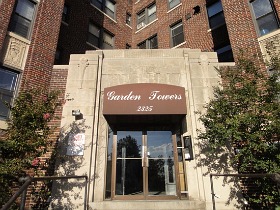What's Hot: The Zones That Could Lead To More Development in Chevy Chase Set To Go Before Zoning Commission
 $20,000 to Move Out: Anatomy of a TOPA Sale
$20,000 to Move Out: Anatomy of a TOPA Sale
✉️ Want to forward this article? Click here.
UrbanTurf has been getting a number of questions recently about the city’s Tenant Opportunity to Purchase Act (TOPA), so we decided to re-publish an article we ran in 2010 that provided a detailed account of the process. If this article doesn’t meet your TOPA needs, check out this one or this one.
(This article was originally published in April 2010.)
By the end of the month, a number of the residents at the Garden Towers apartment complex just north of U Street will be required to move out. And, thanks to the city’s Tenant Opportunity to Purchase Act (TOPA), they will be paid $20,000 to do so.

The origins of this lucrative deal started back in July 2009, when Urban Investment Partners (UIP) approached Dudley Pro Realty, the owner of the 73-unit apartment complex at 2325 15th Street NW (map), about buying the building. Marred by decades of neglect, the building had languished and fallen into disrepair. Tenants said that their units suffered from water damage, heating issues and a nagging vagrancy problem. Nevertheless, the Garden Towers is located blocks from the booming U Street Corridor, a prime area for developers looking for a new project.
It didn’t take long for Dudley Pro Realty and UIP to agree on terms, and soon a letter was sent to the building’s tenants stating that a sale was pending. Also included in the letter was a detailed explanation of the tenants’ rights under TOPA.
Established more than 30 years ago, TOPA gives DC tenants the right of first refusal if their building is contracted to sell. A prospective sale on the building triggers the tenants’ right to organize a tenant association to either acquire the building themselves or to negotiate a sales contract with a third party of their choosing. So, final execution of the sale between UIP and Dudley Pro Realty became subject to whether or not the Garden Towers tenants’ decided to exercise any of these rights.
They did decide to exercise their TOPA rights and formed a tenant association, and selected Kermit Turner, a 15-year resident of the building, to represent them in any negotiations. Though Mr. Turner had experience as a community organizer, he had never organized a tenant association and knew very little about TOPA rights.
“I’m not a person who can stand back and just let things happen,” Turner told UrbanTurf. “And I figured that if the tenants had not been organized, the building would be sold and we could have wound up on the street.”

Exterior of Garden Towers
Turner met with tenant advocacy groups and retained the legal services of Rick Eisen, a prominent TOPA attorney based in the District. As the process moved forward, tenants in the association were asked to contribute a small fee to pay for the attorney. In return, Eisen met with the tenants, advised them on their rights and surveyed their needs and demands. “The primary purpose [of TOPA] is to give tenants bargaining power,” Eisen said. “When there is a major change in the way a building operates, tenants should have a significant say.”
The first order of business was to hold a vote to determine whether to convert the building into condos, co-ops or keep it rentals. A majority of the tenants decided to keep the building rental and to negotiate the sale with a third party developer. “I was willing to go condo,” said Turner, who was one of six tenants who voted to convert the building to condos. “But most of the people were reluctant to enter into any form of ownership because it was a foreign idea to them.”
In January 2010, Eisen and the tenant association board approached several developers about bidding on the building. “At first we got offers from four or five developers and then we whittled it down to three,” Turner explained. The building was in such disrepair that one developer pulled out because it didn’t have the capital to bring it back up to code. That winter and into the spring, the tenant association negotiated offers between the final two would-be buyers, UIP (the original purchaser) and Adams Investment Group, a local DC development firm. “We wanted to choose between a good deal and a great deal, so we let them duke it out,” Turner said.
In August, the tenant association accepted Adams Investment Group’s terms and the building was sold for $6.2 million. Under the terms of the deal, the developer gave each tenant the option to stay or voluntarily end their lease. If a tenant decided to stay, the developer would provide $500 of custom upgrades to the unit, one month’s free rent and there could be no more than a once a year cost of living rent increase for as long as the tenant lived in the same unit. However, if a tenant agreed to leave the building, they would be given a $20,000 early termination fee.
“There was a tiered structure to the buyout to incentivize as many people as possible to leave,” said Will Smith, a tenant in the building. “If X amount of people took the buyout they would give each tenant $10,000, if Y amount they would pay $15,000. Eventually, if 20 or more people agreed to move out, the buyout reached $20,000.” At that point Smith, along with more than 20 of his neighbors, accepted the $20,000 buyout and made plans to move.
“It was pretty easy,” Rick Eisen remembers. “Everybody acted reasonably and the sale was remarkably smooth. UIP was disappointed but they understood that those were the rules of the game.” This July, UIP purchased the Warrington and Wilmington apartment buildings on Wyoming Avenue in Adams Morgan, and the firm began its $4.8 million renovation of the buildings this week. Both buildings were acquired as a result of a combined TOPA condo conversion agreement.
As for Kermit Turner, he decided to stay in his apartment at Garden Towers because he likes the neighborhood and couldn’t imagine living anywhere else. Plus, because the negotiated agreement also called for Adams to improve the building itself, Garden Towers should improve dramatically under the new ownership. Renovations to the interior and exterior have already begun.
“The board and I were able to get a pretty damn good deal,” he said.
Those who move in once Adams Investment Group completes the renovation of the vacant and occupied units will not be getting a deal. After all, the way Adams can afford to buy out exiting tenants for $20,000 is that the vacated units will be re-rented at market rates to new incoming tenants.
“The people who move in [after the renovation] will probably pay twice as much as the people who moved out,” Eisen said.
See other articles related to: columbia heights, dclofts, topa, u street corridor, urban investment partners
This article originally published at https://dc.urbanturf.com/articles/blog/20000_to_move_out_anatomy_of_a_topa_sale/2596.
Most Popular... This Week • Last 30 Days • Ever

A look at the closing costs that homebuyers pay at the closing table.... read »

3331 N Street NW sold in an off-market transaction on Thursday for nearly $12 million... read »

Today, we take an updated look at the pipeline of larger residential development on t... read »

As we continue to delve into metrics that shaped the DC-area housing market this year... read »

The development group behind the hotel has submitted for permit review with DC's Hist... read »
DC Real Estate Guides
Short guides to navigating the DC-area real estate market
We've collected all our helpful guides for buying, selling and renting in and around Washington, DC in one place. Start browsing below!
First-Timer Primers
Intro guides for first-time home buyers
Unique Spaces
Awesome and unusual real estate from across the DC Metro













